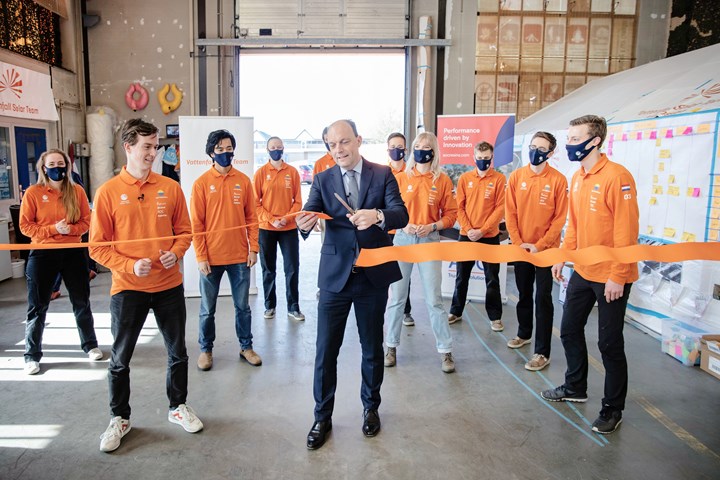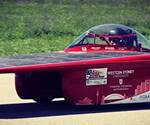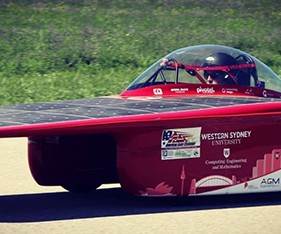TU Delft Nuna11 integrates composites for Bridgestone World Solar Challenge
In preparation for the 2023 solar-powered car race, the Vattenfall Solar Team is optimizing vehicle weight with AOC styrene-free resins for the Nuna11’s structure and shell.

Photo Credit: TU Delft
In preparation for the Australian-based, bi-annual Bridgestone World Solar Challenge — a premier solar-powered car race where global engineers compete with self-designed solar cars, which was rescheduled for October 2023 — the Vattenfall Solar Team from Delft University of Technology (TU Delft, Netherlands) has begun production of their newest solar car, Nuna11. Said to be safer, faster and more efficient than its predecessors, the 11th solar car made by TU Delft students will boast several new composite features. AOC AG (Schaffhausen, Switzerland) will be providing hands-on support during vehicle manufacturing, as well as supply its Beyone styrene-free resins for the car’s structure and shell.
Per the original plan, Nuna11 will be built according to the Bridgestone World Solar Challenge regulations, which requires competitors to use silicon solar cells, increase cockpit size for driver safety and mount a license plate to the back of the car — said to be the largest challenge for Nuna11’s design, as its trailing edge has always been made smooth and aerodynamic.
With the changing regulations, it is expected that competitiveness between the solar race teams will increase. “We like to be challenged, as this forces us to be very inventive,” comments Christiaan Wiers, team captain of the Vattenfall Solar Team. “These new requirements promote innovation in design, electrical and drive systems, which surely is helping us to push the limits of solar technology. Later this year, we will be showing several new car features that help to increase car performance.”
TU Delft says its previous 2019 solar-powered vehicle, NunaX, was the lightest solar car to ever participate in the solar race at 133 kilograms. Nuna11, alternately, will be slightly bigger and heavier; reliance on more environmentally friendly and affordable silicone solar cells versus gallium for its solar panels have increased their surface area from 2.6 to 4 square meters. While this reportedly eliminates a layer of glass typically used to protect the solar cells (the team will instead be applying its own protective coating to save weight and increase the intensity of the light on the panel’s surface), Nuna11 will require more carbon fiber-reinforced laminate for its body to support the larger panels. Thus, the Vattenfall Solar Team says, there is also a need for additional weight optimization.
To achieve this, the Nuna11 will be made with AOC’s Beyone styrene-free resin systems. These sustainable resins feature close-to-zero smell and solvent emissions, and are environmentally preferred alternatives to conventional styrene-based resin systems. The Vattenfall Solar Team says the results are a vehicle that combines light weight, excellent aerodynamics and dimensional stability at elevated temperatures.
Construction of the Nuna11 vehicle will be done by the Polymer Science Park (Zwolle, Netherlands), next to the AOC R&D Center. “AOC is supporting the Vattenfall Solar Team with innovative composites application technology, and provides hands-on support in manufacturing,” says Paul Vercoulen, CTO of AOC EMEA. “The construction is made as lightweight as possible. Also, it's stiffer, stronger and more fire resistant compared to previous Nuna versions, which makes it the fastest, safest and most energy-efficient car.”
The team has also focused on Nuna11’s additional safety. During the last edition of the Bridgestone World Solar Challenge in 2019, the NunaX caught fire for yet unknown reasons, and burnt down. Since then, the team says it has thoroughly investigated the incident. Although it could not pinpoint to one exact cause, they plan to make sure that all potential causes are identified and excluded in the design and structure of Nuna11. These include the production of a safer battery, a changed battery-storage solution and an improved electrical system.
In the next few months, the team will focus on building its solar car and performing an extensive series of tests. The students are being supported by former Dutch national hockey coach Marc Lammers. Most of the tests will take place in the Netherlands. When date and location of the next solar race are confirmed, the team members and Nuna11 will travel to this location for on-site performance tests and preparation.
Related Content
SMC composites progress BinC solar electric vehicles
In an interview with one of Aptera’s co-founders, CW sheds light on the inspiration behind the crowd-funded solar electric vehicle, its body in carbon (BinC) and how composite materials are playing a role in its design.
Read MoreTPI manufactures all-composite Kenworth SuperTruck 2 cab
Class 8 diesel truck, now with a 20% lighter cab, achieves 136% freight efficiency improvement.
Read More“Structured air” TPS safeguards composite structures
Powered by an 85% air/15% pure polyimide aerogel, Blueshift’s novel material system protects structures during transient thermal events from -200°C to beyond 2400°C for rockets, battery boxes and more.
Read MoreBladder-assisted compression molding derivative produces complex, autoclave-quality automotive parts
HP Composites’ AirPower technology enables high-rate CFRP roof production with 50% energy savings for the Maserati MC20.
Read MoreRead Next
2018 American Solar Challenge is underway
Participating vehicles are typically constructed of a carbon fiber monocoque chassis and powered by solar arrays and lithium ion batteries.
Read MoreCutting 100 pounds, certification time for the X-59 nose cone
Swift Engineering used HyperX software to remove 100 pounds from 38-foot graphite/epoxy cored nose cone for X-59 supersonic aircraft.
Read More
























